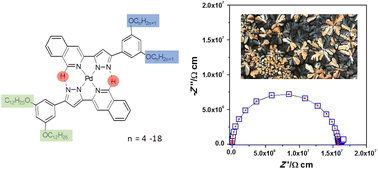Improving the mesomorphism in bispyrazolate Pd(ii) metallomesogens: an efficient platform for ionic conduction†
Abstract
The introduction of structural asymmetry in metallomesogens is an established strategy to improve their mesomorphic behaviour in terms of lower melting temperatures and higher stability ranges of the mesophase, which is particularly important for metallomesogens that have potential application as electrolytes that require wide operational temperature ranges. Here in this work, a novel series of unsymmetrical bis(isoquinolinylpyrazolate)palladium(II) compounds bearing four alkyl side-chains with different lengths are described. Rectangular and hexagonal columnar mesophases were formed with low melting temperatures of 42–45 °C in most cases, whereas the clearing temperatures reached values up to 412 °C. The charge transport properties have been studied by complex impedance spectroscopy, showing that the mesophase favours proton conduction in the absence of water or humidity. The exceptional thermal stability of these species makes them promising candidates to act as a platform for ionic conduction via the nanochannels originated in the columnar mesophases. The results presented confirm that introducing structural asymmetry in the Pd(II) metallomesogens studied is a valid strategy to enhance the liquid crystalline properties, which opens new ways to develop water-free electrolytes based on unsymmetrical bis(isoquinolinylpyrazolate) Pd(II) compounds for potential applications such as proton exchange membranes (PEMs).



 Please wait while we load your content...
Please wait while we load your content...